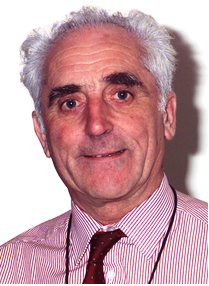 Born in Pyle (Vale of Glamorgan), Brian Bluck attended Bridgend County Grammar School and Cardiff Technical College before proceeding to University College, Swansea to read for a degree in Geology. There he was much influenced by the inspirational teaching of T R (Dick) Owen. This, together with a childhood spent in a South Wales Coalfield village, triggered Brian’s interest in Upper Carboniferous rocks. Thus, after gaining his BSc (1958) he embarked on a PhD project focused on the sedimentology and detailed stratigraphy of Lower Coal Measures sequences in the NE part of the South Wales Coalfield. Gilbert Kelling and Dick Owen co-supervised Brian who (in 1961) gained the first PhD in Sedimentology from that College.
Born in Pyle (Vale of Glamorgan), Brian Bluck attended Bridgend County Grammar School and Cardiff Technical College before proceeding to University College, Swansea to read for a degree in Geology. There he was much influenced by the inspirational teaching of T R (Dick) Owen. This, together with a childhood spent in a South Wales Coalfield village, triggered Brian’s interest in Upper Carboniferous rocks. Thus, after gaining his BSc (1958) he embarked on a PhD project focused on the sedimentology and detailed stratigraphy of Lower Coal Measures sequences in the NE part of the South Wales Coalfield. Gilbert Kelling and Dick Owen co-supervised Brian who (in 1961) gained the first PhD in Sedimentology from that College.
Illinois
Prof. Frank Rhodes encouraged Brian to apply, successfully, for a postdoctoral position at the University of Illinois (Urbana). Thus Brian (and his new wife, Mary) went to the USA in 1961 for a year. At Urbana, Albert Carozzi lured Brian briefly into the world of carbonates and phosphates, but this deviation was countered by Paul Potter, who persuaded him to work on modern alluvial fans in Death Valley, Nevada. Thus began Brian’s career-long interests in coarse clastic sediments, both in modern environments and the rock record.
Returning to Swansea as a Post-Doctoral Research Fellow, Brian helped to build a major research programme on the geological and sedimentological evolution of the South Wales Coalfield, established under the leadership of Dick Owen and Gilbert Kelling, that resulted in a stream of publications and doctoral theses on this topic over the following 15 years. Brian’s PDRF sojourn in Swansea also enabled him to commence his prolific output of research publications. Simultaneously, he applied his Nevadan fans experience to a re-interpretation of the Vale of Glamorgan Triassic, and concurrently to elucidation of the processes involved in sedimentation of beach gravels.
In 1963 Brian was appointed Assistant Lecturer in Geology at the University of Glasgow, then successively Lecturer (1965), Senior Lecturer and Reader, becoming a full Professor in 1989. He was awarded a DSc by Glasgow in 1985 and was made Emeritus Professor in Sedimentation and Tectonics upon his retirement.
In the course of this long academic career, Brian’s research interests encompassed subjects such as tectonics and basin evolution, topics stemming from his long term interest in conglomerates, mainly those in the Scottish Old Red Sandstone; the evolution of the Midland Valley of Scotland and the long, complex history of the Highland Boundary Fault. He was an expert field geologist, meticulous in his mapping and data collection. He was also adept at acquiring new skills to achieve his research aims, such as mastering plane-table mapping in order to record the internal bedforms of three-dimensional fluvial bars in the Upper ORS on the Ayrshire coast, and in modern gravel-bed rivers in Fife.
Terranes
Brian was innovative in his collaboration with geochemists (such as those from the SUERC, formerly the East Kilbride Reactor Centre). This enabled him to use isotopic dating techniques on clasts to refine provenance patterns in the Midland Valley Palaeozoics. For him, these data, together with his re-interpretation of the Ballantrae Complex, demonstrated that the Palaeozoic history of Scotland involved amalgamation of many small terranes brought together by strike-slip faulting.
Late in his career De Beers invited him to elucidate the development of the Kaapvaal Craton, South Africa, and to determine how its behaviour through time impacted on the Orange River sediment system and the associated transportation and distribution of diamonds! These studies, epitomised by his 2005 GSL SP248 paper on Diamond Megaplacers, greatly enhanced understanding of long-term drainage evolution in southern Africa.
In the course of this long and illustrious career Brian was the recipient of several awards: Geological Society of London Lyell Fund (1981); Royal Society of Edinburgh Keith Medal (1981); Saltire Society of Scotland Award (1991); and Edinburgh Geological Society Clough Medal (1999/2000). He was on the editorial boards of the Journal of Sedimentary Petrology, Scottish Journal of Geology, Transactions of the Royal Society of Edinburgh, and was elected FRSE in 1981.
Inspirational
Brian was an inspirational teacher to successive generations of Geology undergraduates at Glasgow, and a sympathetic mentor to his many postgraduate students. He established co-operative research links with colleagues in N. America, RSA & Namibia, Iceland, India and many places in Europe. His spent most of his life in Scotland (hence his taste for Longmorn-Glenlivet 1967!) but his heritage was Wales (hence his love for music and rugby). He will be greatly missed by numerous friends and the many geologists influenced by his inspired teaching, collaborative research and infectious enthusiasm in the field.
Brian died quietly at home in Old Kilpatrick on 19 June, 2015. He is survived by his loving wife Mary, daughter Emma, son Tim and four grandchildren.
By Brian Williams, with thanks to Mary Bluck, Tim Dempster & Gilbert Kelling